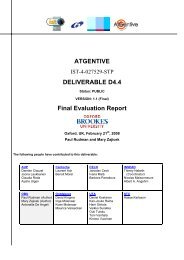pdf 820Kb - INSEAD CALT
pdf 820Kb - INSEAD CALT
pdf 820Kb - INSEAD CALT
You also want an ePaper? Increase the reach of your titles
YUMPU automatically turns print PDFs into web optimized ePapers that Google loves.
1 Introduction<br />
Evaluation report of the use of Onto-Logging<br />
platform in the user site<br />
Deliverable ID: D8b<br />
Page : 6 of 110<br />
Version: 1.0<br />
Date: 27 january 2004<br />
Status: Final<br />
Confid.: Public<br />
The main goal of this document is to propose and to apply a framework for the evaluation of<br />
the Ontologging System – a next generation ontology-based knowledge management<br />
platform– that has been designed as part of the Ontologging IST project.<br />
This document tries to provide a complete view of the evaluation:<br />
The rational for the evaluation, what are the methods available, what methods have been<br />
selected for evaluating the Ontologging system, how these methods are operationalized,<br />
executed, and how is the result analysed.<br />
This document is structured in several sections.<br />
The first section presents the methodological aspects and principles of the evaluation: what is<br />
the evaluation for? What can be evaluated? What should be evaluated? What are the different<br />
methods available to conduce an evaluation? Etc.<br />
The second section presents how these principles are to be applied to the concrete evaluation<br />
of the different components of the Ontologging platform (a next generation, ontology-based<br />
knowledge management platform). In particular, this section establishes an action plan for<br />
evaluating the system, and in particular defines the methods that have been chosen to capture<br />
the data.<br />
The next section (chapter 4) is related to the execution of the action plan of the evaluation. It<br />
presents concretely the setting of the evaluation (what is the context of the evaluation, who<br />
are the participant), the elaboration of the instrument and the collection of the data.<br />
Then, the following sectio n is concerned with the analysis of the data, and of the result of the<br />
evaluation (this section may be empty at an initial stage of this document). This section also<br />
presents how the different results are taken into account in order to improve the system.<br />
Finally, the last section draws the main conclusion of this evaluation, and defines some future<br />
work in this domain to be conducted.
















